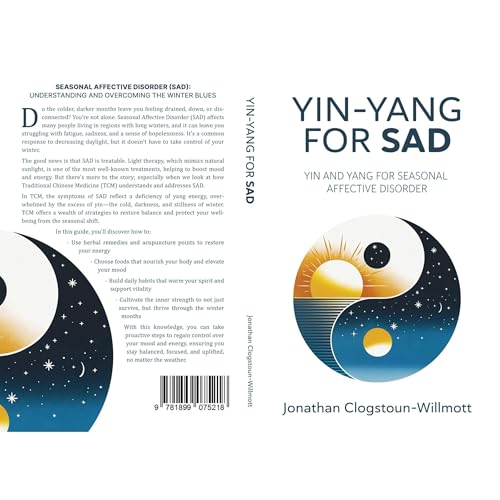
Yin-Yang for SAD
Yin-Yang theory applied to Seasonal Affective Disorder (SAD)
No se pudo agregar al carrito
Add to Cart failed.
Error al Agregar a Lista de Deseos.
Error al eliminar de la lista de deseos.
Error al añadir a tu biblioteca
Error al seguir el podcast
Error al dejar de seguir el podcast
Obtén 3 meses por $0.99 al mes + $20 de crédito Audible
 Exclusivo para miembros Prime: ¿Nuevo en Audible? Obtén 2 audiolibros gratis con tu prueba.
Exclusivo para miembros Prime: ¿Nuevo en Audible? Obtén 2 audiolibros gratis con tu prueba.
Compra ahora por $4.99
-
Narrado por:
-
Virtual Voice

Este título utiliza narración de voz virtual
Seasonal Affective Disorder (SAD): Understanding and Managing the Winter Blues
SAD, or Seasonal Affective Disorder, impacts many people living in extreme latitudes of both the Northern and Southern Hemispheres. First identified in the 1980s, this condition arises during the winter months when daylight hours decrease, and sunlight intensity diminishes. Common symptoms include fatigue, depression, feelings of hopelessness, and overeating.
The most well-known remedy is light therapy, often involving exposure to a sunlamp, which mimics natural sunlight and helps regulate mood and energy levels.
In traditional Chinese medicine (TCM), these symptoms are considered a manifestation of yang deficiency in response to an excess of yin—a reflection of the cold, dark, damp, and gloomy winter environment. TCM offers a variety of time-tested strategies to address this imbalance and build resilience against the "winter blues."
This book provides a comprehensive guide to understanding yang energy and how to strengthen it during the colder months. It includes practical advice on:
- Herbal remedies and acupuncture points to restore balance.
- Foods to eat and avoid for optimal energy and mood.
- Actions and habits to maintain warmth and vitality.
- The importance of nurturing your spirit and techniques to cultivate it.
With this knowledge, you can take proactive steps to stay balanced and uplifted through the challenges of winter.


